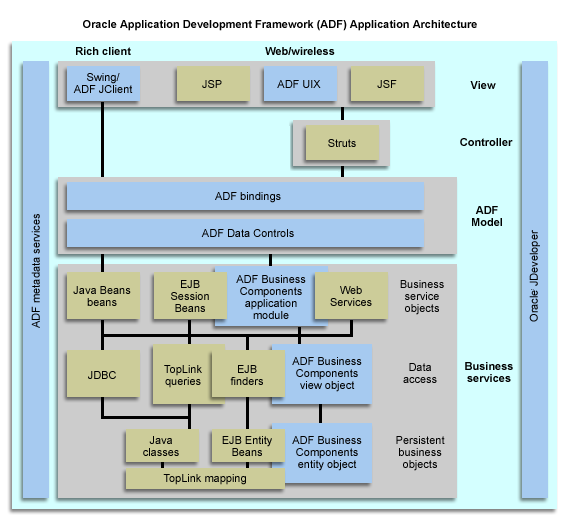
The Java 2 Enterprise Edition (J2EE) platform provides a multi-tiered model for enterprise-caliber, interactive applications. Applications designed for the J2EE platform can run on different devices, including information system backend servers, middle-tier application servers, and client machines. A simplified description of the J2EE application architecture includes the following logical tiers:
Within each of these tiers, J2EE defines a large number of design patterns that application developers must become familiar with to code applications to the platform's standards.

The above diagram displays components implemented by Oracle ADF in blue. All other components can be combined through the Oracle ADF model objects as desired to create flexible application partitions for the J2EE application. The glue that integrates the various components of J2EE applications and makes development so flexible is the Oracle ADF model layer.
The Role of Oracle ADF on the J2EE Platform
Oracle Application Development Framework (Oracle ADF) plays a significant role in developing J2EE applications. While J2EE involves many different technologies and employs a diverse infrastructure to deploy enterprise applications, many of the design patterns are common to distributed applications and should be abstracted into a runtime framework. Without the aid of a framework such as Oracle ADF, the various J2EE and web services technologies must be defined at the interface level. Indeed, developing enterprise applications typically requires one or more architects to design the high-level application model and developers to code the solution completely by hand.
The role of Oracle ADF in part is to support deployed applications that fit into the robust, scalable, and flexible architecture of the J2EE platform. When developers work with ADF and develop applications in JDeveloper, as one solution, they can work with the following familiar technologies to write less code while benefiting from the J2EE platform infrastructure:
Additionally, the design time tools provided by JDeveloper aid the developer with visual, declarative, and guided-code functionality to utilize the underlying runtime framework and J2EE architecture. For example, as an alternative solution, if application developers work with the following technologies, provided by Oracle ADF, they are relieved entirely of the need to code to the J2EE design patterns:
For further details about how JDeveloper lets you combine technologies to suit your application development needs, see About Oracle ADF Project Technologies.
Because Oracle ADF implements so many of the required J2EE design patterns and has full support within JDeveloper, developers who are not necessarily trained in Java or J2EE may focus entirely on the application logic and not on the underlying technologies required to deploy distributed applications with data-driven functionality.
For the entire Sun Microsystems document describing interactive applications based on MVC, see this web page:
http://java.sun.com/blueprints/guidelines/designing_enterprise_applications_2e/DEA2eTOC.html
About the MVC Design Pattern and
Oracle ADF
About the Model 2 Versus
Model 1 Architecture
About J2EE Application Clients and Oracle ADF
About the Design Time for Oracle ADF
About the Oracle ADF Data Controls
About the Oracle ADF Binding Context
About the Oracle ADF Lifecycle
Copyright © 1997, 2004, Oracle. All rights reserved.